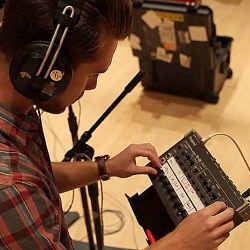Personal monitoring systems, aka IEM systems, come in all shapes and sizes but which is best for a particular band?
There are five levels of these systems which drive product selection and a few brands have been highlighted.
Level 1: Basic IEM System
This is as simple as it gets. The Rolls PM351 has been the go-to minimalistic monitor system for years. Each unit works by plugging the musician’s microphone or instrument into the small box and then inputs and outputs run to and from the audio console. The user can control the mix of their floor wedge or headphones by having three volume controls; the incoming mix, the musician’s microphone, and the musician’s instrument.
It’s the cheapest option. A six-person band can be equipped for under $500. However, it’s got its disadvantages. It’s messy with the amount of cable routing and it’s limited to what can be mixed. But for some very small bands, it’s perfect.
Level 2: Multi-Channel Control, Limited Functionality
At this point, the personal monitoring systems give musicians independent control over every channel. In short, the musicians can create their own monitor mix.
There aren’t many options at level two and that’s ok because Elite Core has a great product in this area. The Elite Core PM-16 is more than a step up from the Rolls. The Rolls is a box, the PM-16 is a system. A rack unit in the sound booth takes in 16 inputs and routes that either to the individual units or, using a better setup, to a distribution unit on the stage which then routes the digital signal to the mixer units all via cat-5e cable. Cost for a seven-person band runs in the $4k+ range.
Each personal mixer unit provides a master three-band EQ, compressor, and a master volume while also providing individual volume and pan controls for sixteen channels. That’s my favorite part of the PM-16 – a one-to-one channel-to-knob scenario. While advanced digital mixers can offer more options per channel, they require selection of the channel and then control of that option which may or may not be buried in a menu. An on-board ambient microphone is useful to hear non-singing musicians talking during practice.
What you see is what you get and for a lot of musicians, that’s what they want and nothing more. Each channel on the unit has a signal-strength light so it’s easy to identify an excessively loud channel. Mixers are powered via cat-5e cable unless daisy-chaining the cat-5e cable across units in which case AC power is required.
Level 3: Advanced Functionality
The big players are Aviom, Hearback, and Allen & Heath. Each of these systems build on the level 2 ideas but provide more configurability. They can do as much or as little as the musicians need – up to a point.
For example, the Aviom 320 personal mixer (part of a full Aviom system) has fewer capabilities than the A360 but guess what? It outsells the A360. It’s cheaper but most musicians don’t need the extra features. It does have a nice feature of adding reverb to the mix for a more live sound.
There’s an interesting IEM system from Digital Audio Labs called the LiveMix. In short, two people can share one controller unit. Each musician can set their own mix. There is a lot it can do but it’s definitely for musicians who can handle it.
The cost for these systems runs $4k and up for a seven-person band. The number of channels that each system can handle can vary from 16 channels to more. Some of these systems also offer wireless-device control.
There is a more complex system, in this level, from Roland but it requires a Roland console.
Level 4: Wireless-Only
This gets into a rather cloudy area. Some of the modern digital consoles include wireless personal monitor mixing capability. There’s also the Pivitec personal monitoring system that providing mixing only through iPhones and iPads and requires Pivitec hardware components to make it work. Wireless can be great but the best means of setting up such systems is providing them a dedicated Wi-Fi network.
Level 5: Full-Service
MyMix has everything the other systems have plus more. Specifically, multi-track recording capability. Yes, record to an SD card from the personal mixing unit. Then, play back to practice when the band isn’t around or use the recording for mixing down songs at home. Is this system a lot more expensive any other system? Surprisingly, no.
The biggest thing to remember about personal monitoring systems is it’s not what they can do, it’s what the musicians need them to do and how well they can use them. Systems in levels 3+ can vary a lot in functionality so check out the market and see what brands and models are available and compare that to what’s needed.
Got a band that wants to take home their jams to practice or record their own album, go with the MyMix. Got a band that just wants to set a few levels, then you’ve got a lot of other options.
Chris Huff is a long-time practitioner of church sound and writes at Behind The Mixer, covering topics ranging from audio fundamentals to dealing with musicians – and everything in between.
















